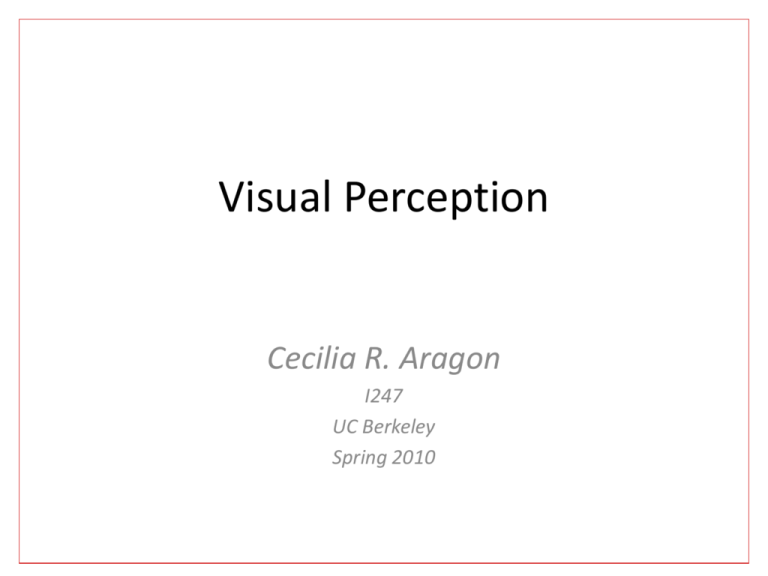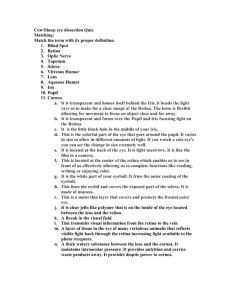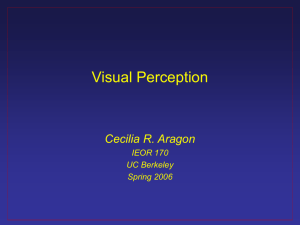Visual Perception lecture
advertisement

Visual Perception Cecilia R. Aragon I247 UC Berkeley Spring 2010 Acknowledgments • Thanks to slides and publications by Marti Hearst, Pat Hanrahan, Christopher Healey, Maneesh Agrawala, and Lawrence AndersonHuang, Colin Ware, Daniel Carr. Spring 2010 I 247 2 Visual perception • • • • • • • • Thinking with our Eyes Structure of the Retina Preattentive Processing Detection Estimating Magnitude Change Blindness Multiple Attributes Gestalt Spring 2010 I 247 3 Thinking with our Eyes • 70% of body’s sense receptors reside in our eyes • Metaphors to describe understanding often refer to vision (“I see,” “insight,” “illumination”) • “The eye and the visual cortex of the brain form a massively parallel processor that provides the highest-bandwidth channel into human cognitive centers.” – Colin Ware, Information Visualization, 2004 • Important to understand how visual perception works in order to effectively design visualizations Spring 2010 I 247 4 Thinking with our Eyes • Working memory is extremely limited • How to overcome? • “The processing of grouping simple concepts into more complex ones is called chunking.” – Ware, 2004 • “The process of becoming an expert is largely one of learning to create effective chunks.” – Ware, 2004 Spring 2010 I 247 5 The Power of Visualization • “It is possible to have a far more complex concept structure represented externally in a visual display than can be held in visual and verbal working memories.” – Ware, 2004 Spring 2010 I 247 6 How the Eye Works The eye is not a camera! Attention is selective (filtering) Cognitive processes Psychophysics: concerned with establishing quantitative relations between physical stimulation and perceptual events. Spring 2010 I 247 7 How to Use Perceptual Properties • Information visualization should cause what is meaningful to stand out Spring 2010 I 247 8 The Optimal Display • Typical monitor: 35 pixels/cm • = 40 cycles per degree at normal viewing distances • Human eye: receptors packed into fovea at 180 per degree of visual angle • So a 4000x4000-pixel resolution monitor should be adequate for most visual perception tasks Spring 2010 I 247 9 Optimal spatial resolution • Humans can resolve a grating of 50 cycles per degree (~44 pixels per cm) • Sampling theory (Nyquist) states: need to sample at twice the highest frequency needed to detect • So… why is 150 pixels per degree not sufficient (cf. laser printers at 460 dots per cm)? • 3 reasons: aliasing, gray levels, superacuities • (will be discussed in future lecture) Spring 2010 I 247 10 Structure of the Retina Spring 2010 I 247 11 Structure of the Retina • The retina is not a camera! • Network of photo-receptor cells (rods and cones) and their connections [Anderson-Huang, L. http://www.physics.utoledo.edu/~lsa/ _color/18_retina.htm] Spring 2010 I 247 12 Photo-transduction • When a photon enters a receptor cell (e.g. a rod or cone), it is absorbed by a molecule called 11-cis-retinal and converted to trans form. • The different shape causes it to ultimately reduce the electrical conductivity of the photo-receptor cell. [Anderson-Huang, L. http://www.physics.utoledo.edu/~lsa/_color/18_retina.htm] Spring 2010 I 247 13 • Photoreceptors: Retina – 120 million rods, more sensitive than cones, not sensitive to color – 6-7 million cones, color sensitivity, concentrated in macula (central 12 degrees of visual field) – Fovea centralis - 2 degrees of visual field – twice the width of thumbnail at arm’s length) – Fovea comprises less than 1% of retinal size but 50% of visual cortex Spring 2010 I 247 14 Electric currents from photo-receptors • Photo-receptors generate an electrical current in the dark. • Light shuts off the current. • Each doubling of light causes roughly the same reduction of current (3 picoAmps for cones, 6 for rods). • Rods more sensitive, recover more slowly. • Cones recover faster, overshoot. • Geometrical response in scaling laws of perception. [Anderson-Huang, L. http://www.physics .utoledo.edu/~lsa/_color/18_retina.htm] Spring 2010 I 247 15 Preattentive Processing How many 5’s? 385720939823728196837293827 382912358383492730122894839 909020102032893759273091428 938309762965817431869241024 [Slide adapted from Joanna McGrenere http://www.cs.ubc.ca/~joanna/ ] Spring 2010 I 247 17 How many 5’s? 385720939823728196837293827 382912358383492730122894839 909020102032893759273091428 938309762965817431869241024 Spring 2010 I 247 18 Preattentive Processing • Certain basic visual properties are detected immediately by low-level visual system • “Pop-out” vs. serial search • Tasks that can be performed in less than 200 to 250 milliseconds on a complex display • Eye movements take at least 200 msec to initiate Spring 2010 I 247 19 Color (hue) is preattentive • Detection of red circle in group of blue circles is preattentive [image from Healey 2005] Spring 2010 I 247 20 Form (curvature) is preattentive • Curved form “pops out” of display [image from Healey 2005] Spring 2010 I 247 21 Conjunction of attributes • Conjunction target generally cannot be detected preattentively (red circle in sea of red square and blue circle distractors) [image from Healey 2005] Spring 2010 I 247 22 Healey on preattentive processing http://www.csc.ncsu.edu/faculty/healey/PP/index.html Spring 2010 I 247 23 Preattentive Visual Features line orientation length width size curvature number terminators intersection Spring 2010 closure color (hue) intensity flicker direction of motion stereoscopic depth 3D depth cues I 247 24 Cockpit dials • Detection of a slanted line in a sea of vertical lines is preattentive Spring 2010 I 247 25 Detection Spring 2010 I 247 26 Just-Noticeable Difference • Which is brighter? Spring 2010 I 247 27 Just-Noticeable Difference • Which is brighter? (130, 130, 130) Spring 2010 (140, 140, 140) I 247 28 Weber’s Law • In the 1830’s, Weber made measurements of the just-noticeable differences (JNDs) in the perception of weight and other sensations. • He found that for a range of stimuli, the ratio of the JND ΔS to the initial stimulus S was relatively constant: ΔS / S = k Spring 2010 I 247 29 Weber’s Law • Ratios more important than magnitude in stimulus detection • For example: we detect the presence of a change from 100 cm to 101 cm with the same probability as we detect the presence of a change from 1 to 1.01 cm, even though the discrepancy is 1 cm in the first case and only .01 cm in the second. Spring 2010 I 247 30 Weber’s Law • Most continuous variations in magnitude are perceived as discrete steps • Examples: contour maps, font sizes Spring 2010 I 247 31 Estimating Magnitude Spring 2010 I 247 32 Stevens’ Power Law • Compare area of circles: Spring 2010 I 247 33 Stevens’ Power Law s(x) = axb s is the sensation x is the intensity of the attribute a is a multiplicative constant b is the power b > 1: overestimate b < 1: underestimate Spring 2010 [graph from Wilkinson 99] I 247 34 Stevens’ Power Law Sensation Exponent Brightness 0.33 Smell 0.55 (Coffee) Loudness 0.6 Temperature 1.0 (Cold) Taste 1.3 (Salt) Heaviness 1.45 Electric Shock 3.5 [Stevens 1961] Spring 2010 I 247 35 Stevens’ Power Law Experimental results for b: Length Area Volume .9 to 1.1 .6 to .9 .5 to .8 Heuristic: b ~ 1/sqrt(dimensionality) Spring 2010 I 247 36 Stevens’ Power Law • Apparent magnitude scaling [Cartography: Thematic Map Design, p. 170, Dent, 96] S = 0.98A0.87 [J. J. Flannery, The relative effectiveness of some graduated point symbols in the presentation of quantitative data, Canadian Geographer, 8(2), pp. 96-109, 1971] [slide from Pat Hanrahan] Spring 2010 I 247 37 Relative Magnitude Estimation Most accurate Position (common) scale Position (non-aligned) scale Length Slope Angle Least accurate Spring 2010 Area Volume Color (hue/saturation/value) I 247 38 Change Blindness Spring 2010 I 247 39 Change Blindness • An interruption in what is being seen causes us to miss significant changes that occur in the scene during the interruption. • Demo from Ron Rensink: http://www.psych.ubc.ca/~rensink/flicker/ Spring 2010 I 247 40 Possible Causes of Change Blindness [Simons, D. J. (2000), Current approaches to change blindness, Visual Cognition, 7, 1-16. ] Spring 2010 I 247 41 Multiple Visual Attributes Spring 2010 I 247 42 The Game of Set • • • • Color Symbol Number Shading A set is 3 cards such that each feature is EITHER the same on each card OR is different on each card. [Set applet by Adrien Treuille, http://www.cs. washington.edu/homes/treuille/resc/set/] Spring 2010 I 247 43 Multiple Visual Attributes • Integral vs. separable Integral dimensions two or more attributes of an object are perceived holistically (e.g.width and height of rectangle). Separable dimensions judged separately, or through analytic processing (e.g. diameter and color of ball). • Separable dimensions are orthogonal. • For example, position is highly separable from color. In contrast, red and green hue perceptions tend to interfere with each other. Spring 2010 I 247 44 Integral vs. Separable Dimensions Integral Separable [Ware 2000] Spring 2010 I 247 45 Gestalt Spring 2010 I 247 46 Gestalt Principles • • • • • • • • • figure/ground proximity similarity symmetry connectedness continuity closure common fate transparency Spring 2010 I 247 47 Examples Proximity Connectedness [from Ware 2004] Figure/Ground [http://www.aber.ac.uk/media/Modules/MC10220/visper07.html] Spring 2010 I 247 48 Conclusion What is currently known about visual perception can aid the design process. Understanding low-level mechanisms of the visual processing system and using that knowledge can result in improved displays. Spring 2010 I 247 49






